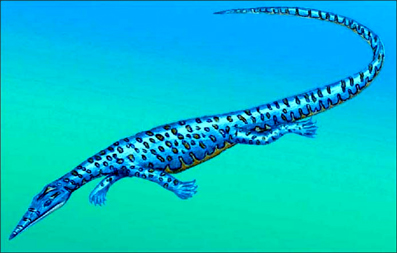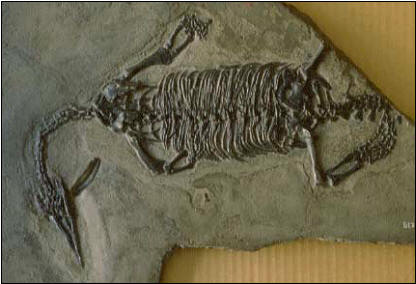
Endennasaurus

Etymology: Reptile from Endenna
Collected Species: Endennasaurus acutirostris
Systematic Palaeontology: Diapsida; Thalattosauria; Endennasauridae
Distribution: Upper strata of the Calcari di Zorzino (Norian Age)
Locality: Endenna (Bergamo, Lombardy, Northern Italy)
Repository: Museo Civico di Scienze Naturali "Caffi" di Bergamo

Endennasaurs is represented by two specimens, the holotype (5170, Bergamo Museum of Natural Sciences), exposed from the ventral side and lacking the left posterior limb and almost the entire tail, and a second specimen (paratype MBSN 27 in the same collection) exposed from the dorsal side and consisting of few dorsal vertebrae and ribs, part of the pelvic girdle, the right femur and the complete tail. The skull is narrow and elongate, the premaxillae are long, forming anteriorly a pointed rostrum and posteriorly a well developed process; both upper and lower jaw and palatine bones are toothless; frontals are long and narrow, forming most the upper margin of the orbits; occiput lying anteriorly to the quadrate suspension; the upper temporal fenestra is slit like or closed as in thalattosaurs. The neck is rather elongate with vertebrae amphicoelous; there are 12 cervical, 16 dorsal , 2 sacral and up to 67 caudal vertebrae. The trunk is stout and heavy with pachyostotic ribs and massive gastralia. The tail is very long and laterally compressed. The humerus is stout, with expanded and flattened distal head. The femur is slender and about twenty per cent longer than the humerus. There are sligthly reduced ossification in the carpus and in the tarsus. The carpus is represented by the ulnare, intermedium and centrale (the radiale was retained as cartilage) along with the first four distal carpals. Fifth distal tarsal is lost; fifth metatarsal is weakly hooked; phalangeal formula of the pes is primitive: 2,3,4,5,4.As suggested by the general structure of the skeleton Enndennasaurus shows a high degree of adaptation toward aquatic life expressed mainly by the stout distally enlarged humerus, the massive gastralia and the long, laterally compressed tail. Endennasaurus could have moved on land better than the other Thalattosaurs and this reptile probably lived near the coast preying on small organisms. Its long pointed "beak" does not seem an adaptation to catch fishes or to prey on hard shelled molluscs. Endennasaurus preys had to be small animals that did not have a strong shell or exoskelton like some crustaceans and small vertebrates.
Artwork by S. Renesto unless otherwise indicated. Please do not reproduce/repost/republish etc. any text or image without asking permission to the author
Home Research Triassic Reptiles